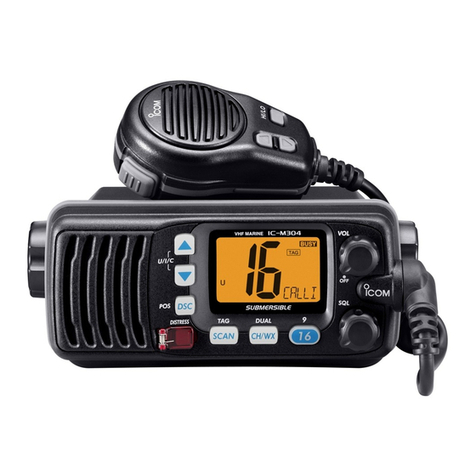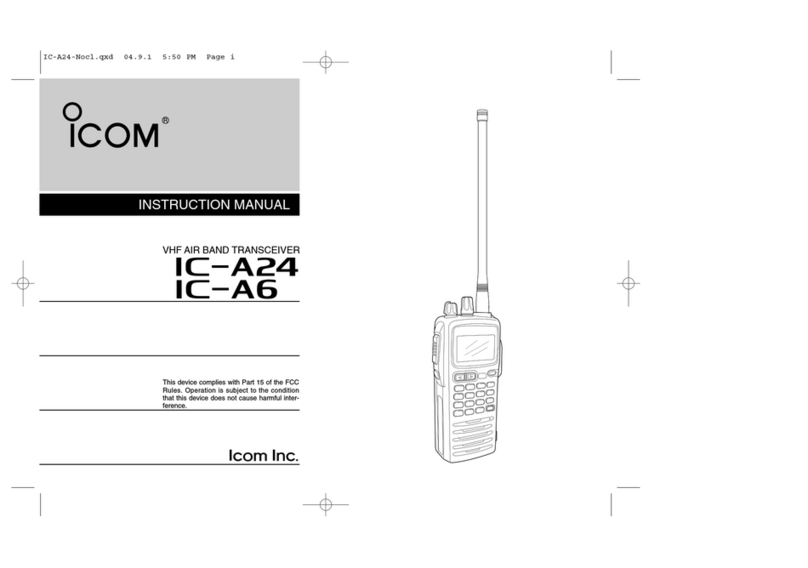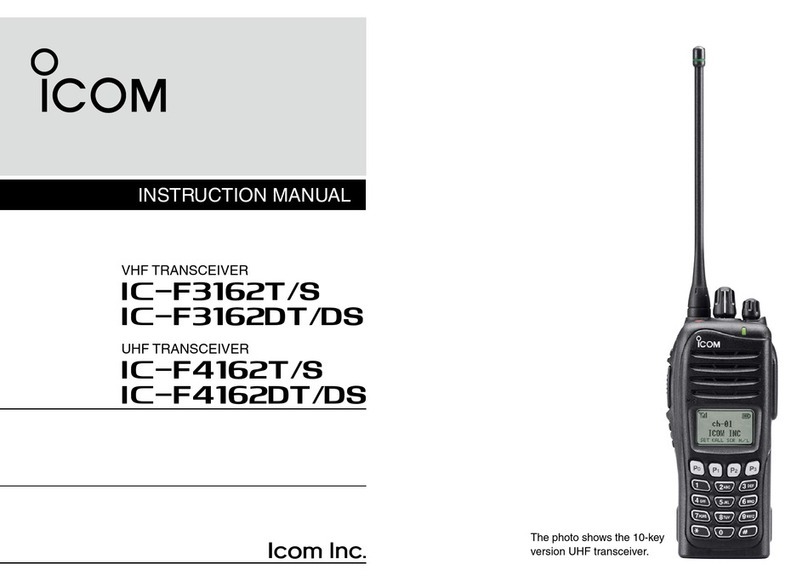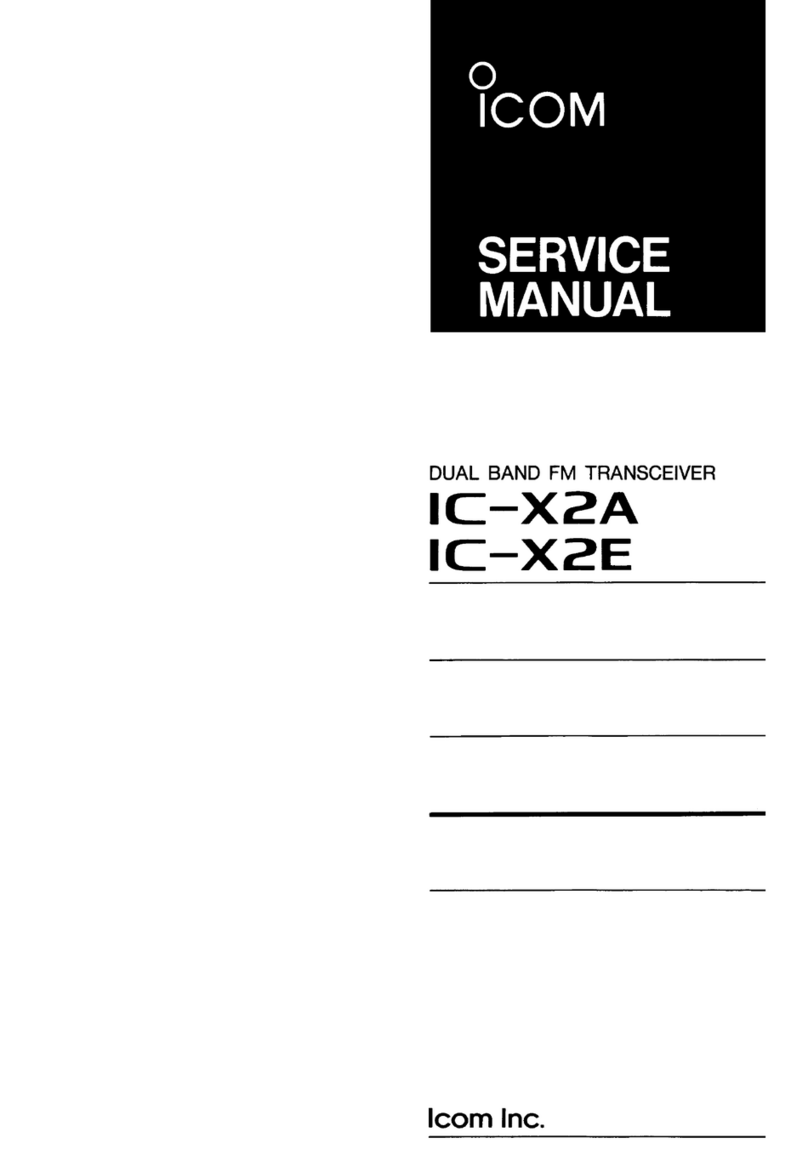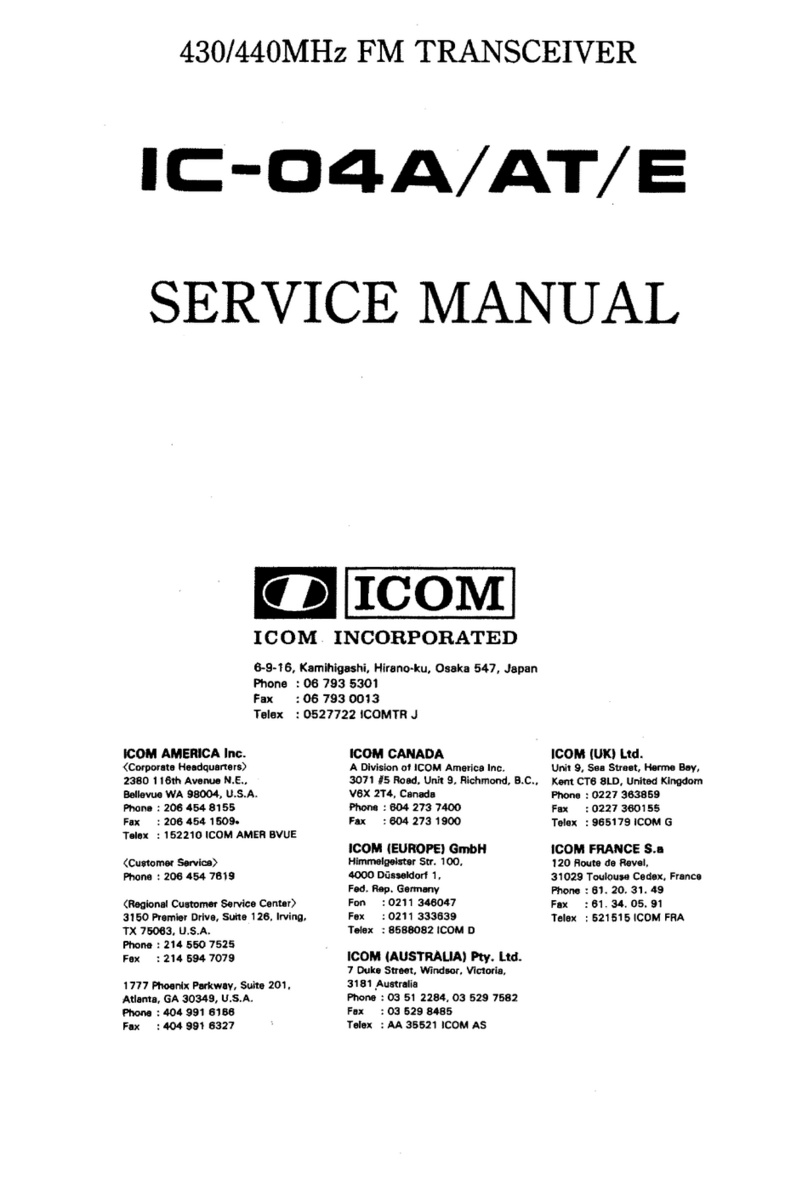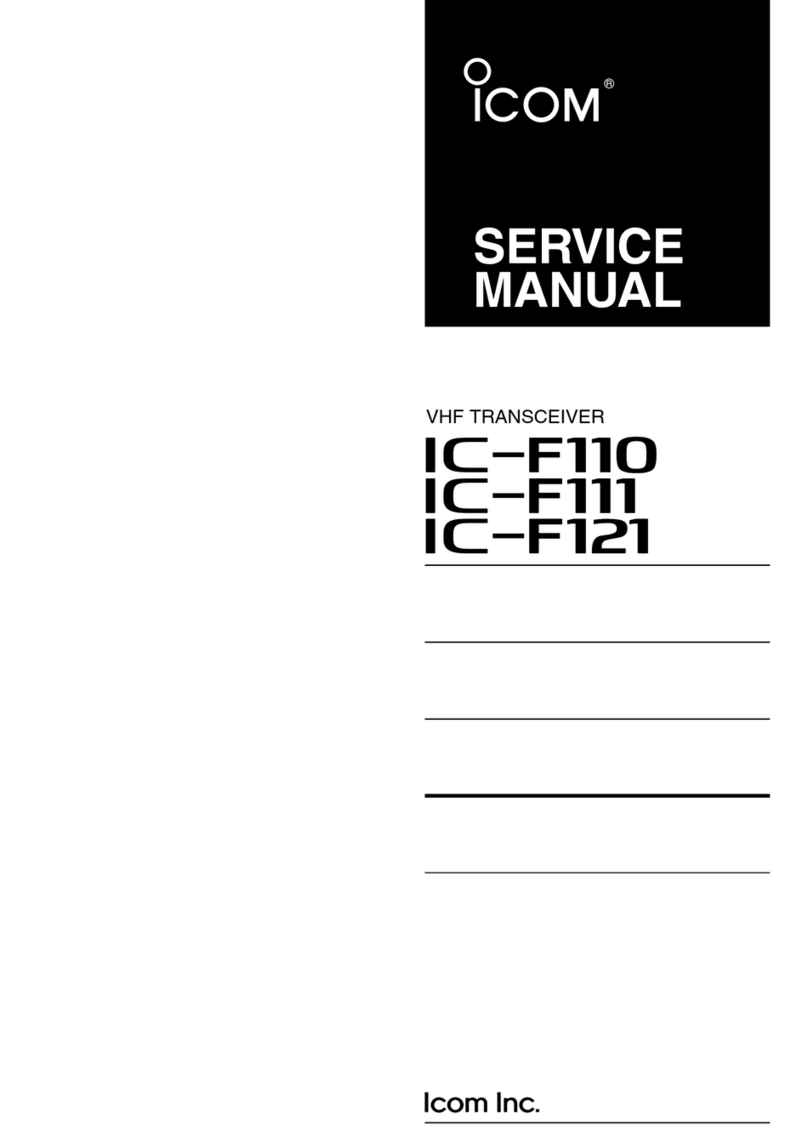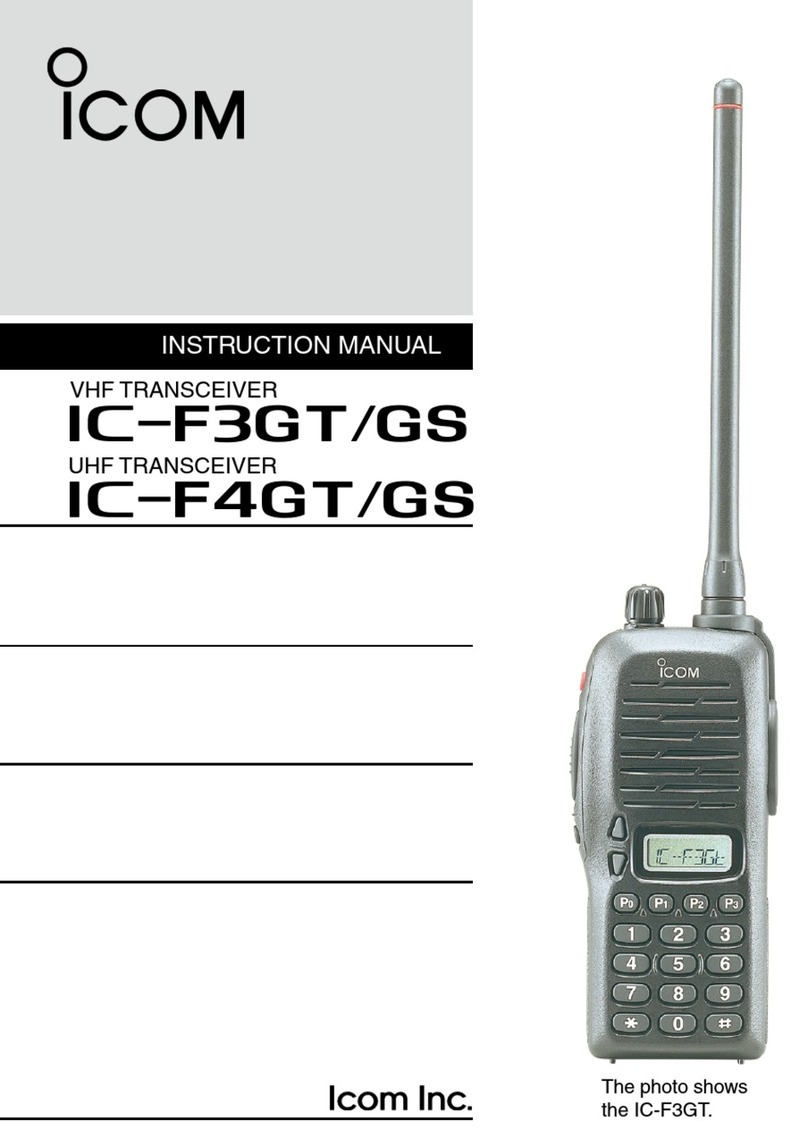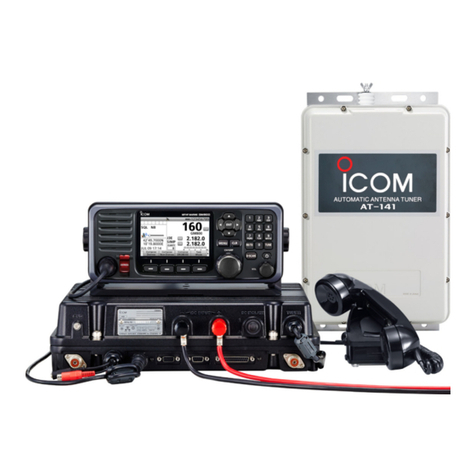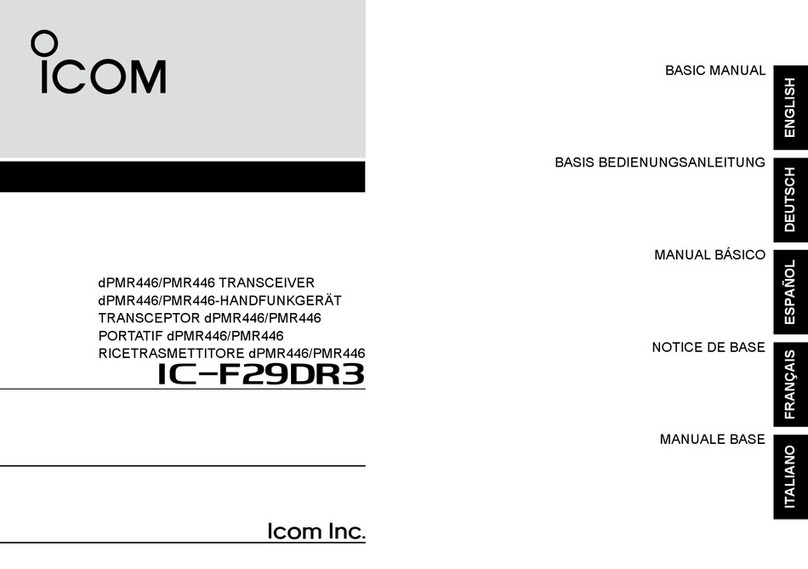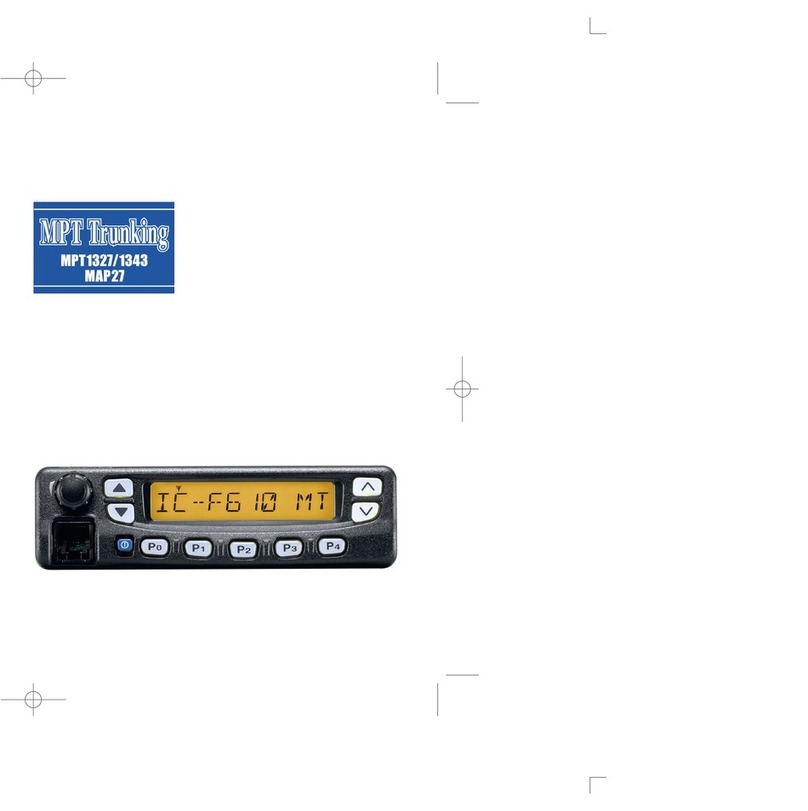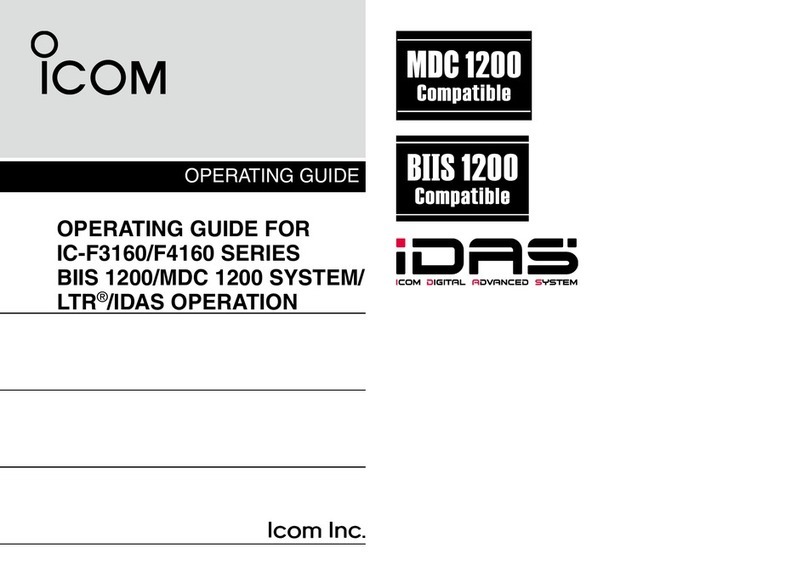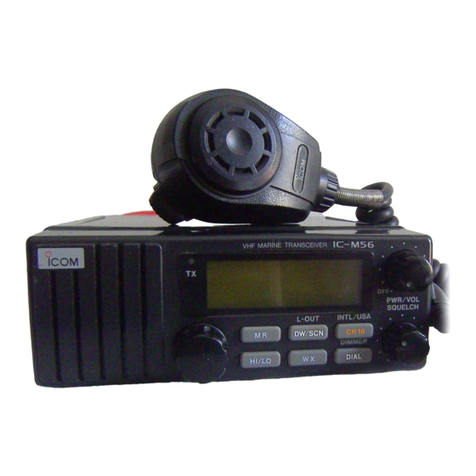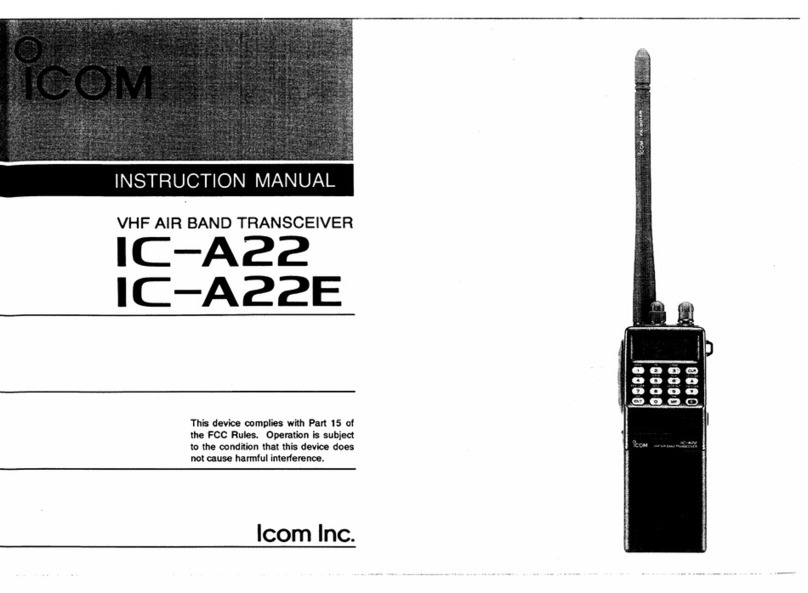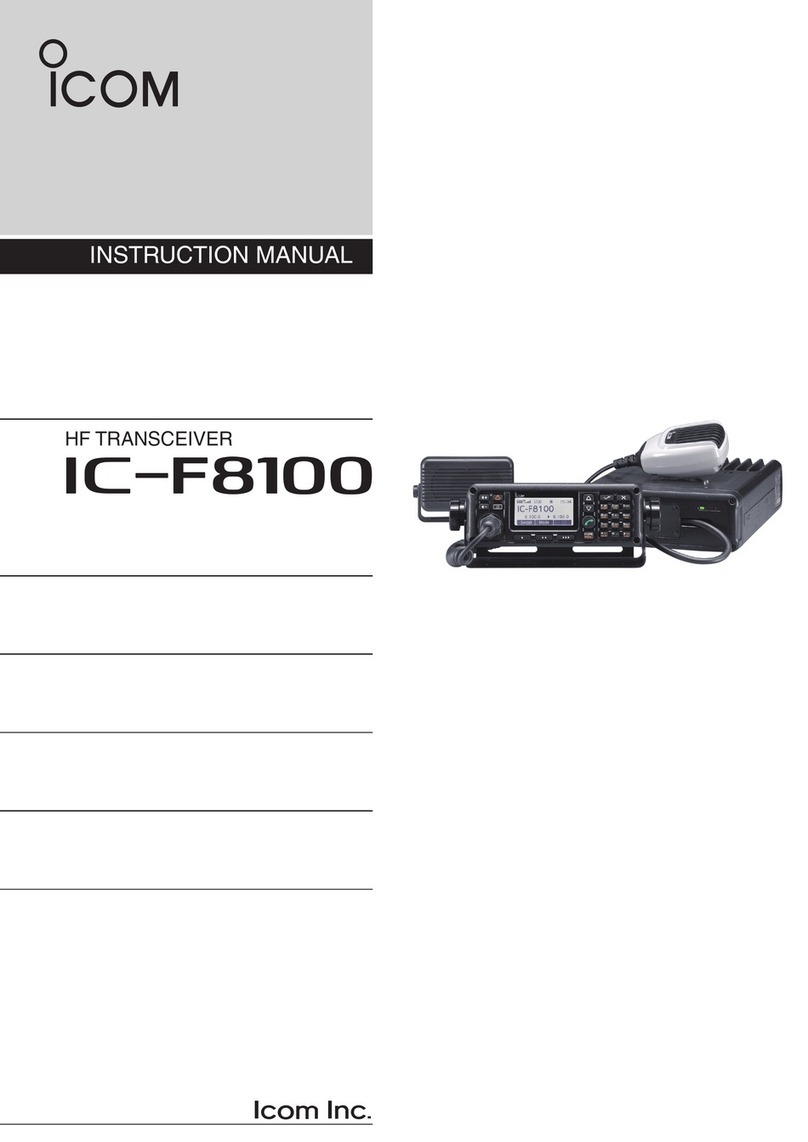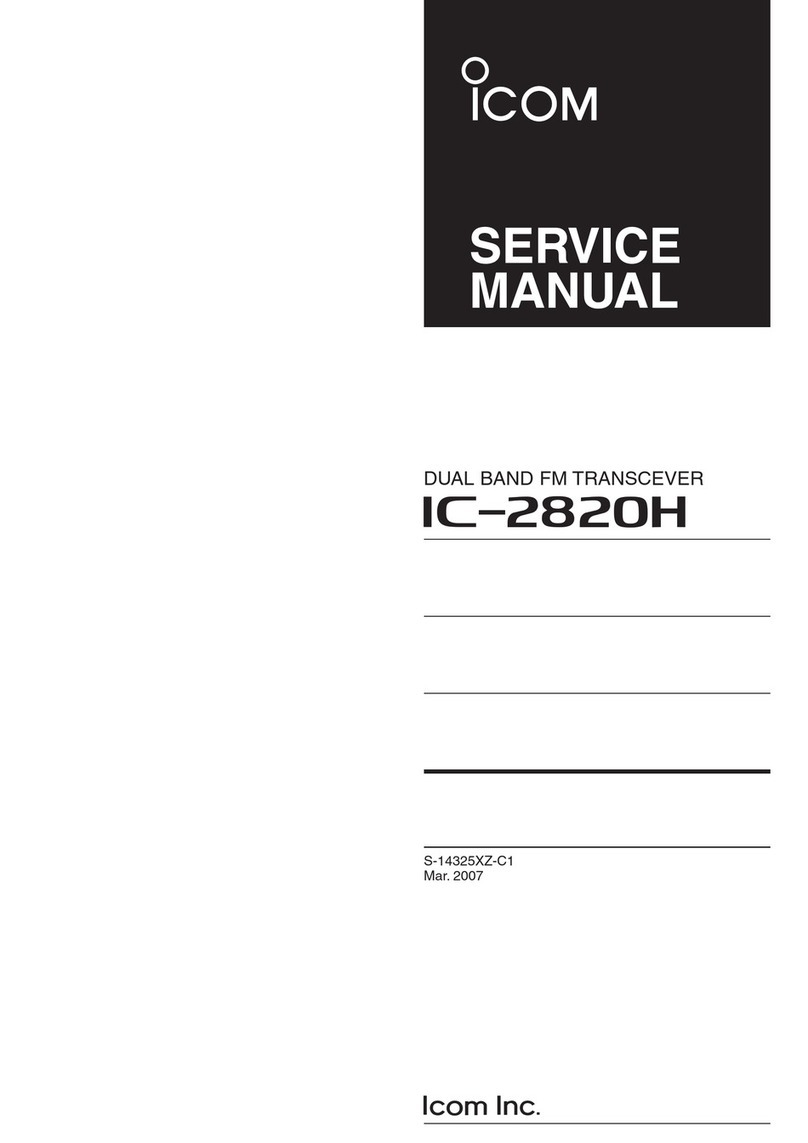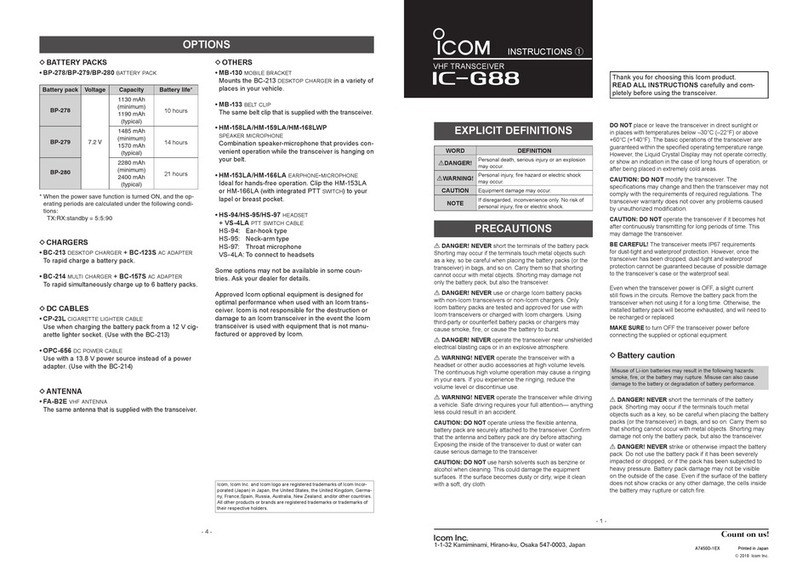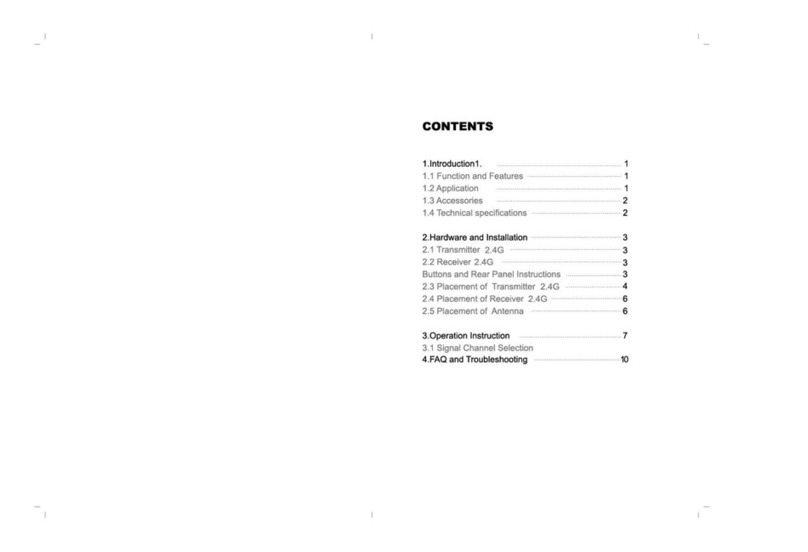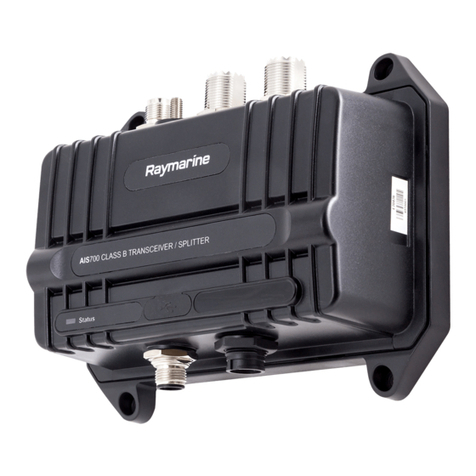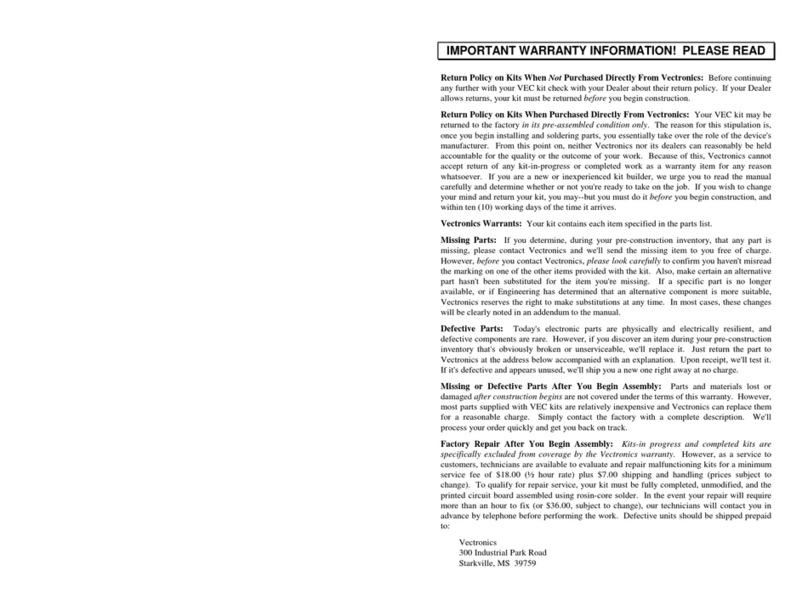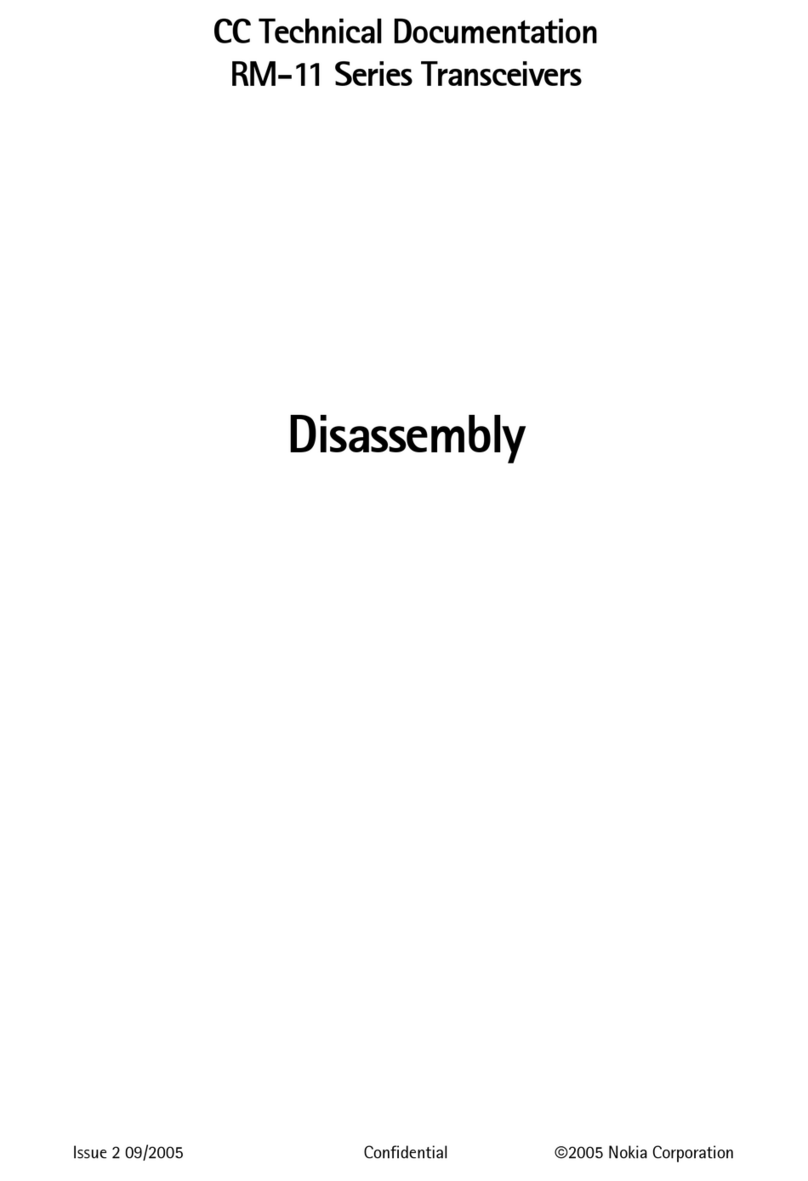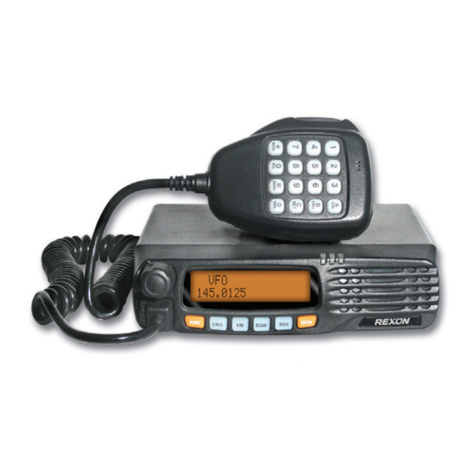Icom IC-F5120D Series User manual

OPERATING GUIDE
OPERATING GUIDE FOR
IC-F5120D/F6120D SERIES
MDC 1200 SYSTEM/
IDAS™ OPERATION
Limited functions only
Limited functions only

i
Thank you for purchasing this Icom transceiver.
The MDC 1200 system and IDAS™ (Icom Digital Advanced
System) functions are built into your IC-F5120D/F6120D se-
ries transceiver.
READ ALL INSTRUCTIONS carefully and completely
before using the transceiver.
SAVE THIS OPERATING GUIDE — This operating
guide contains important operating instructions for:
• IC-F5121D, IC-F5122D, IC-F5123D and IC-F5128D VHF
MOBILE TRANSCEIVERS
• IC-F6121D, IC-F6122D, IC-F6123D and IC-F6128D UHF
MOBILE TRANSCEIVERS
INFORMATION: The 10-keypad of the optional HM-152T
DTMF microphone has only DTMF code transmitting ca-
pability. Therefore, IDs and messages cannot be input
using the microphone.
Icom, Icom Inc. and the Icom logo are registered trademarks of Icom Incor-
porated (Japan) in Japan, the United States, the United Kingdom, Germany,
France, Spain, Russia and/or other countries.
IDAS and the IDAS logo are trademarks of Icom Incorporated (Japan).
All other products or brands are registered trademarks or trademarks of their
respective holders.
IMPORTANT
The AMBE+2™ voice coding Technology embodied in this
product is protected by intellectual property rights including
patent rights, copyrights and trade secrets of Digital Voice
Systems, Inc. This voice coding Technology is licensed
solely for use within this Communications Equipment.
The user of this Technology is explicitly prohibited from
attempting to extract, remove, decompile, reverse engineer,
or disassemble the Object Code, or in any other way convert
the Object Code into a human-readable form. U.S. Patent
Nos. #8,595,002, #8,359,197, #8,315,860, #8,200,497,
#7,970,606, #6,912,495 B2.
VOICE CODING TECHNOLOGY

ii
TABLE OF CONTENTS
IMPORTANT.......................................................................... i
VOICE CODING TECHNOLOGY .......................................... i
TABLE OF CONTENTS........................................................ ii
1 PREPARATION................................................................1
■Programmable function keys ........................................1
2 MDC 1200 OPERATION..............................................2–3
■MDC 1200 system operation........................................2
■Receiving a call ............................................................2
■Transmitting a call.........................................................3
3 IDAS OPERATION ....................................................4–16
■IDAS operation .............................................................4
■IDAS Trunk operation ...................................................4
■Receiving a call ............................................................4
■Transmitting a call.......................................................10
■Transmitting Position data...........................................15
■Transmitting Status message .....................................15
■Sounding a Horn ........................................................15
■Connecting a Printer ..................................................16
■Using Voice Encryption ..............................................16

1
1PREPARATION
■Programmable function keys
The following functions can be assigned to the [UP], [DOWN],
[P0], [P1], [P2] and [P3] programmable function keys.
Consult your Icom dealer or system operator for details con-
cerning your transceivers preprogramming.
DFor only IDAS operation
DIGITAL BUTTON KEY
➥Push [Digital Button] to enter the application selection
mode.
➥Hold down for 1 second to toggle the call type between
Individual and Talkgroup, and then automatically enter the
application selection mode.
• Push the [CH Up] or [CH Down] key to select the “VOICE,”
“CALLALRT,” “STATUS,” “MSG,” or “CALL LOG” application.
➥While in the application selection mode, push to enter the
Individual or Talkgroup ID selection mode.
• If “STATUS” or “MSG” is selected as the application, the message
selection mode appears. Push the [CH Up] or [CH Down] key to
select the desired message, then push [Digital Button] again to
enter the Individual or Talkgroup ID selection mode. (pp. 12, 13)
➥
While in the application selection mode, hold down [Digital
Button] for
1 second to return to the normal operating
mode.
STATUS UP/DOWN KEYS
➥When a Short Data Message (SDM) is displayed, push to
cancel the automatic scroll and manually scroll the mes-
sage.
➥When an SDM that contains more than 8 characters is dis-
played, push to manually scroll the message.

2
2
MDC 1200 OPERATION
1
2
3
4
5
6
7
8
9
10
11
12
13
14
15
16
■MDC 1200 system operation
The MDC 1200 signaling system enhances your transceiv-
er’s
capabilities. It allows PTTID*, Emergency signaling, and
receiving a Radio Check. Also, the dispatcher can stun and
revive transceivers on the system.
An additional feature of the MDC 1200 system in Icom trans-
ceivers is called aliasing. Each transceiver on the system has
a unique ID number. Aliasing allows substituting an alphanu-
meric name for the ID number. When transmitting, you can use
this alias to select a transceiver to call. When a call is received,
the alias of the calling station is displayed instead of the ID.
*When [PTT] is pushed or released, the transceiver transmits your
station ID.
NOTE: During MDC 1200 system operation, IDAS opera-
tion capability is disabled.
■Receiving a call
DReceiving an Emergency Call
qWhen an emergency call is received:
• Beeps sound.
• The calling station ID (or alias) and “EMG EMG” are alternately
displayed.
w
To stop the beep and display indication, turn OFF the
power, change the channel or push [PTT].
DReceiving a Stun and Revive
The dispatcher can send MDC 1200 system signals that
will stun or revive your transceiver. If a Stun command that
matches your station ID is received, the transceiver will dis-
play “SORRY” (default) and you cannot receive* or transmit.
When a Revive command that matches your station ID is
received, normal operation is restored and “SORRY” disap-
pears.
(* Except Revive command signals)

3
2MDC 1200 OPERATION
■Transmitting a call
DPTTID Calls
The transceiver can send an MDC 1200 system signal that
includes PTTID when [PTT] is pushed (begin transmitting)
and released (stop transmitting). If a PTTID call is received,
the transceiver will display the calling station’s ID (or alias)
and sound a beep.* (*Depending on the preprogramming.)
DTransmitting an Emergency Call
When [Emergency] (described in the instruction manual) is
held down for a specified time period,* the emergency signal
is once or repeatedly transmitted on the specified emergency
channel.
When no emergency channel is specified, the call is
transmitted on the operating channel.
The repeat emergency signal is automatically transmitted
until you turn OFF the power.
Depending on the preprogramming, receiving an
acknowledgement may cancel the transmission.
If you want to cancel the Emergency function, hold down
[Emergency] for the preprogrammed time period again before
transmitting the call.
If your transceiver is programmed for Silent operation, you
can transmit emergency calls without the beep sounding and
the LCD display changing.
IMPORTANT: Setting an individual emergency channel is
recommended for dependable emergency call operation.
*Depending on the preprogramming, the following functions can be
automatically activated. Ask your dealer for details.
DNOTES
• Auto TX function
After an emergency call transmission, audio from the
microphone is automatically transmitted for a specified time
period.
• The HM-148G or HM-152 hand microphone is required.
• Auto RX function
After an emergency call transmission, the transceiver stands
by in the audible mode for a specified time period.

4
3
IDAS OPERATION
1
2
3
4
5
6
7
8
9
10
11
12
13
14
15
16
■IDAS operation
The IC-F5120D and IC-F6120D series use the Icom Digital
Advanced System (IDAS) that meets the 6.25 kHz emission
mask requirements for narrow banding. IDAS increases ef-
ficiency of channel allocation and use of the RF spectrum.
NOTE: During IDAS operation, MDC 1200 system opera-
tion capability is disabled.
■IDAS Trunk operation
The IDAS Trunk system enables further effective channel
management by sharing a minimum of channels with a large
number of users.
Push [Zone], then push [CH Up] or [CH Down]* to select the
IDAS Trunk zone.
* The method to select the desired zones may differ, depending on
your system set up.
NOTE: During IDAS Trunk operation, you can receive and
transmit digital calls in the same way as IDAS operation,
as described in ‘■Receiving a call,’ ‘■Transmitting a call.’
■Receiving a call
DReceiving a Voice Call
qWhen a Voice call is received:
• Mute is released.
• While receiving the signal, either the calling station or Talkgroup
ID name (or code) can be displayed, depending on the prepro-
gramming.
• When an All Call signal is received, “ALL CALL” is displayed.
The calling station or
Talkgroup ID name
wHold down [PTT], then speak into the microphone.
eRelease [PTT] to receive.

■Receiving a call (continued)
DReceiving a Call Alert
qWhen a Call Alert signal is received:
• Beeps sound.
• “ ” blinks.
• The calling station or Talkgroup ID name (or code) and
“CALLALRT” alternately appear.
The calling station or
Talkgroup ID name
Blinks
wHold down [PTT], then speak into the microphone.
eRelease [PTT] to receive.
DReceiving a Status Message
qWhen a Status Message is received:
• Beeps sound.
• The calling station or Talkgroup ID name (or code) and the sta-
tus message alternately appear.
The calling station or
Talkgroup ID name
The status
message
wTo clear the ID and message display, push [PTT], turn OFF
the power or change the channel.
5
3IDAS OPERATION

6
3
IDAS OPERATION
1
2
3
4
5
6
7
8
9
10
11
12
13
14
15
16
DReceiving a Message
qWhen a Message is received:
• Beeps sound.
• The calling station ID name (or code) and the message alter-
nately appear.
The calling station or
Talkgroup ID name
The message
NOTE: When the message includes more than
8 characters, and the automatic scroll function is activated,
the message automatically scrolls.
• Push [Status Up] or [Status Down] to manually scroll the mes-
sage.
Scrolls
wTo clear the ID and message display, push [PTT], turn
power OFF or change the channel.
DReceiving a Stun, Kill or Revive
If an Individual call with a Stun or Kill command is received,
the transceiver will display “SORRY” and you can not receive*
or transmit. (RAN code matching may not be necessary, de-
pending on the preprogramming.)
* Depending on the received Stun command setting. Revive signals
can always be received.
➥When a Stun command is received:
• The transceiver cannot be operated until an Individual call a Re-
vive command is received, or you enter a password. (RAN code
matching may not be necessary, depending on the preprogram-
ming.)
➥When a Kill command is received:
• The transceiver cannot be operated until data cloning is per-
formed. Ask your dealer for details.
NOTE: Depending on the preprogramming, the transceiver
can ignore the Stun, Revive and Kill commands that are
from a non-specified station.

7
3IDAS OPERATION
■Receiving a call (continued)
DReceiving a Remote Monitor, Radio Check
or Status Polling Call
If an Individual call with a Remote monitor, Radio Check or
Status polling command is received, the transceiver will au-
tomatically transmit. (RAN code matching may not be neces-
sary, depending on the preprogramming.)
➥When a Remote monitor command is received:
• The microphone audio is automatically transmitted for the set
time period.
➥When a Radio Check command is received:
• An acknowledgement call is automatically transmitted.
➥When a Status polling command is received:
• A status call is automatically transmitted.
DReceiving an Emergency call
qWhen an emergency call is received:
• Beeps sound.
• “STAT EMR” and the calling station ID name (or code) alternately
appear.
• The state of the backlight depends on the Backlight setting in
the User Set mode. When “LIGT AUT” is selected, the backlight
turns ON for the preprogrammed time period. (Auto Backlight
Timer)
The calling station
ID name
wTo clear the beep, ID and message display, turn OFF the
power or change the channel.

8
3
IDAS OPERATION
1
2
3
4
5
6
7
8
9
10
11
12
13
14
15
16
DDisplaying the received call log
If activated, the log stores received calls into the transceiver’s
memory.
Up to 10 calls can be stored, and the oldest call record is
erased when an 11th call is received. However, once the trans-
ceiver is turned OFF, the log is erased.
The Individual voice call, Call alert, Status call and Message
call are
stored
.
q
Push [Digital Button] to enter the application selection mode.
• “VOICE” appears.
•
To change to the desired call type, hold down [Digital Button] for
1 second
while in standby. After changing, the transceiver auto-
matically enters the application selection mode.
w Push [CH Up] or [CH Down] to select “CALL LOG.”
ePush [Digital Button] again to display the call log informa-
tion.
When log information is displayed
The calling station
ID name
When there is no log information
rPush [CH Up] or [CH Down] to select the desired call.
tHold down [PTT] to send a voice call.
• A voice call can be made with the logged station.

9
3IDAS OPERATION
■Receiving a call (continued)
DTalk Back function
The talk back function allows you to select the same call
mode (Analog or Digital) and/or call type (Individual or Talk-
group) as the received call.
When the talk back timer is set to 0 seconds, this function is
not activated. Ask your dealer for setting details.
If this function is cancelled by pushing [Digital Button] or any
other keys, or after the talk back timer period has passed,
the transceiver automatically returns to the default call mode
and type.
If the received call is a digital signal, the talk back function is
activated only for Voice Call, Call Alert, Status Message and
Message.*
* Depending on the preprogramming, the talk back function may be
activated for only Voice Call.
When the channel type is “Mixed-Analog”
After receiving a digital signal, you can select the digital call
mode by pushing [PTT] before or during the talk back timer
period.
When the channel type is “Mixed-Digital”
After receiving an analog signal that can release the mute,
you can select the analog call mode by pushing [PTT] before
or during the talk back timer period.
When the channel type is “Mixed-Digital” or “Digital”
After receiving a digital signal, you can select the same call
type for the received call (Individual or Talkgroup), by pushing
[PTT] before or during the talk back timer period.
NOTE:
When the Talk Back function is not activated, the trans-
ceiver transmits an analog signal on a “Mixed-Analog”
channel, and transmits a digital signal on a “Mixed-Digital”
channel.
• The transceiver receives both analog and digital signals on the
“Mixed-Analog” and “Mixed-Digital” channels, regardless of this
function.

10
3
IDAS OPERATION
1
2
3
4
5
6
7
8
9
10
11
12
13
14
15
16
■Transmitting a call
IDAS operation allows you to make a call to a specific station
(Individual call) or to a specific group (Talkgroup call). Other
digital mode transceivers on the channel will not hear a call
that does not match their Individual or Talkgroup ID and/or
RAN (Radio Access Number) code.
DTransmitting a Voice Call
qPush [Digital Button] to enter the application selection
mode.
• “VOICE” appears.
•
To change to the desired call type, hold down [Digital Button] for
1 second
while in standby. After changing, the transceiver auto-
matically enters the application selection mode.
* This illustration shows an Individual type call.
wPush [Digital Button] again to enter the Individual or Talk-
group ID selection mode.
• The preprogrammed ID name is displayed.
• When an ID name is not programmed, ID code is displayed.
• The primary ID can be preset to display first.
• When you want to make a voice call to all transceivers within
the communication range, use the ‘All Call’ function; select the
Talkgroup ID code “65535.”
ePush [CH Up] or [CH Down] to select a desired an ID name
or ID code.
Individual or Talkgroup
ID name is displayed.
r
Hold down [PTT], then speak into the microphone.
tRelease [PTT] to receive.

11
3IDAS OPERATION
■Transmitting a call (continued)
DTransmitting a Call Alert
Call Alert allows you to alert another user, who may be away
from their transceiver, whom you want to talk to.
qPush [Digital Button] to enter the application selection
mode.
• “VOICE” appears.
•
To change to the desired call type, hold down [Digital Button] for
1 second
while in standby. After changing, the transceiver auto-
matically enters the application selection mode.
w Push [CH Up] or [CH Down] to select “CALLALRT.”
ePush [Digital Button] again to enter the Individual or Talk-
group ID selection mode.
• The preprogrammed ID name is displayed.
• When an ID name is not programmed, the ID code is displayed.
• The primary ID can be preset to display first.
rPush [CH Up] or [CH Down] to select the desired ID name
(or ID code).
Individual or Talkgroup ID name is displayed.
tHold down [PTT] to transmit the Call Alert to the selected
station or Talkgroup.
• “CA CALL” is displayed.
yRelease [PTT].
• After receiving an acknowledgement from the targeted station,
“CA OK” is displayed.
• If the targeted station does not receive the signal or send back
an acknowledgement, “CA FAIL” is displayed.
uAfter a specified time period has passed, the transceiver
will return to receive.

12
3
IDAS OPERATION
1
2
3
4
5
6
7
8
9
10
11
12
13
14
15
16
DTransmitting a Status Message
The transceiver has the ability to send a preprogrammed sta-
tus message.
There are up to 100 status messages that can be sent.
qPush [Digital Button] to enter the application selection
mode.
• “VOICE” appears.
•
To change to the desired call type, hold down [Digital Button] for
1 second
while in standby. After changing, the transceiver auto-
matically enters the application selection mode.
w Push [CH Up] or [CH Down] to select “STATUS.”
ePush [Digital Button] again to enter the status message
selection mode.
• A preprogrammed status message is displayed.
rPush [CH Up] or [CH Down] to select the desired mes-
sage.
Preprogrammed status message is displayed.
tPush [Digital Button] again to enter the Individual or Talk-
group ID selection mode.
• The preprogrammed ID name is displayed.
• When an ID name is not programmed, the ID code is displayed.
• The primary ID can be preset to display first.
yPush [CH Up] or [CH Down] to select the desired ID name
(or ID code).
Individual or Talkgroup ID name is displayed.
uPush [PTT] to transmit the status message.
• “STAT TX” is displayed.
iRelease [PTT].
• “STAT OK” is displayed after receiving an acknowledgement
from the base station.
• “STA FAIL” is displayed if there is no acknowledgment from the
base station.
oAfter a specified time period has passed, the transceiver
will return to standby.

13
3IDAS OPERATION
■Transmitting a call (continued)
DTransmitting a Message
The transceiver has the ability to send a preprogrammed
message.
There are 10 messages that can be sent.
qPush [Digital Button] to enter the application selection
mode.
• “VOICE” appears.
•
To change to the desired call type, hold down [Digital Button] for
1 second
while in standby. After changing, the transceiver auto-
matically enters the application selection mode.
w Push [CH Up] or [CH Down] to select “MSG.”
ePush [Digital Button] again to enter the message selection
mode.
• The preprogrammed message is displayed.
r
Push [CH Up] or [CH Down] to select the desired message.
Preprogrammed message is displayed.
tPush [Digital Button] again to enter the Individual or Talk-
group ID selection mode.
• The preprogrammed ID name is displayed.
• When an ID name is not programmed, the ID code is displayed.
• The primarily ID can be preset to display first.
yPush [CH Up] or [CH Down] to select the desired ID name
(or ID code).
Individual or Talkgroup ID name is displayed.
uPush [PTT] to transmit the message.
• “MSG TX” is displayed.
iRelease [PTT].
• “MSG OK” is displayed after receiving an acknowledgement
from a base station.
• “MSG FAIL” is displayed if there is no acknowledgment from the
base station.
oAfter a specified time period has passed, the transceiver
will return to standby.

14
3
IDAS OPERATION
1
2
3
4
5
6
7
8
9
10
11
12
13
14
15
16
DTransmitting an Emergency Call
When [Emergency] (described in the instruction manual) is held
down for the specified time period, the emergency signal is trans-
mitted once or repeatedly* on the emergency channel. When no
emergency channel is specified, the signal is transmitted on the
operating channel.
* When the Repeat Cancel function is ON, the transceiver cancels
repeat calling after receiving an acknowledgement.
When the Repeat Cancel function is OFF, the transceiver continues
to call according to the number of repeat cycles, even after receiv-
ing an acknowledgement.
Individual or Talkgroup call types of emergency calls can be
preset. If the call type is not preset, the default or selected
call type is used.
If you want to cancel the emergency call, hold down
[Emergency] again before transmitting the call.
The emergency call can be transmitted without sounding
beeps or changing the LCD display, depending on the pre-
programming. (Silent operation)
The transceiver can also be programmed to keep the micro-
phone open during an emergency call, allowing other stations
to monitor the situation.
Ask your dealer for details.
IMPORTANT: Setting an individual emergency channel is
recommended for dependable emergency call operation.
NOTE:
When the Digital Request Ack function is activated, the
transceiver transmits an emergency call with a request to
send back an acknowledgment.

15
3IDAS OPERATION
■Transmitting Position data
When a GPS receiver is connected to the transceiver, the
position (longitude and latitude) data can be automatically
transmitted:
• When the GPS request status message is received
• After sending a voice message
- Set the ‘Send with Voice Call’ item to ‘Enable.’
• After sending a status message
- Set the ‘Send with Status Call’ item to ‘Enable.’
• After sending a message
- Set the ‘Send with SDM Call’ item to ‘Enable.’
• After sending a Call Alert
- Set the ‘Send with Call Alert’ item to ‘Enable.’
• After sending an Emergency call
- Set the ‘Send with Emergency’ item to ‘Enable.’
Ask your dealer or system operator for connection details.
■
Transmitting Status messages
A status message can be automatically transmitted.
A status message is transmitted:
• When the transceiver is turned ON or turned OFF
- Set a status message to be transmitted in ‘Power ON Status’ or
‘Power OFF Status’ item, respectively.
- Set the target station ID in ‘Power Status ID.’
• After sending a voice message
- Set the ‘Send with Voice Call’ item to ‘Enable.’
- Set a status message to be transmitted in the ‘Send Status
Number’ item.
■Sounding a Horn
The automatic honking function can be used when a horn is
connected to the transceiver through the optional ACC cable
OPC-1939 (D-Sub 15-pin) or OPC-2078 (D-Sub 25-pin).
When a status message is received, the transceiver sounds
the vehicle’s horn for the specified time period to inform you
that a status message has being received.
This function is convenient when the operator is away from
the transceiver.
Ask your dealer or system operator, or refer to the IC-F5120D/
F6120D series service manual for connection and setting details.

16
3
IDAS OPERATION
1
2
3
4
5
6
7
8
9
10
11
12
13
14
15
16
■Connecting a Printer
When the printer is connected to the transceiver through the
OPC-2078, the received SDM content and the called station
ID can be printed out.
Ask your dealer or system operator for connection details.
■Using Voice Encryption
The encryption function enables voice encrypting, which pro-
vides private digital communication between stations.
qPush [Encryption] to turn ON the encryption function.
• “ ” appears.
wPush [Encryption] again to turn OFF the encryption func-
tion.
• “ ” disappears.

1-1-32 Kamiminami, Hirano-ku, Osaka 547-0003, Japan
A6903-2EX-0b
© 2011–2018 Icom Inc.
Other manuals for IC-F5120D Series
1
This manual suits for next models
1
Table of contents
Other Icom Transceiver manuals
Popular Transceiver manuals by other brands
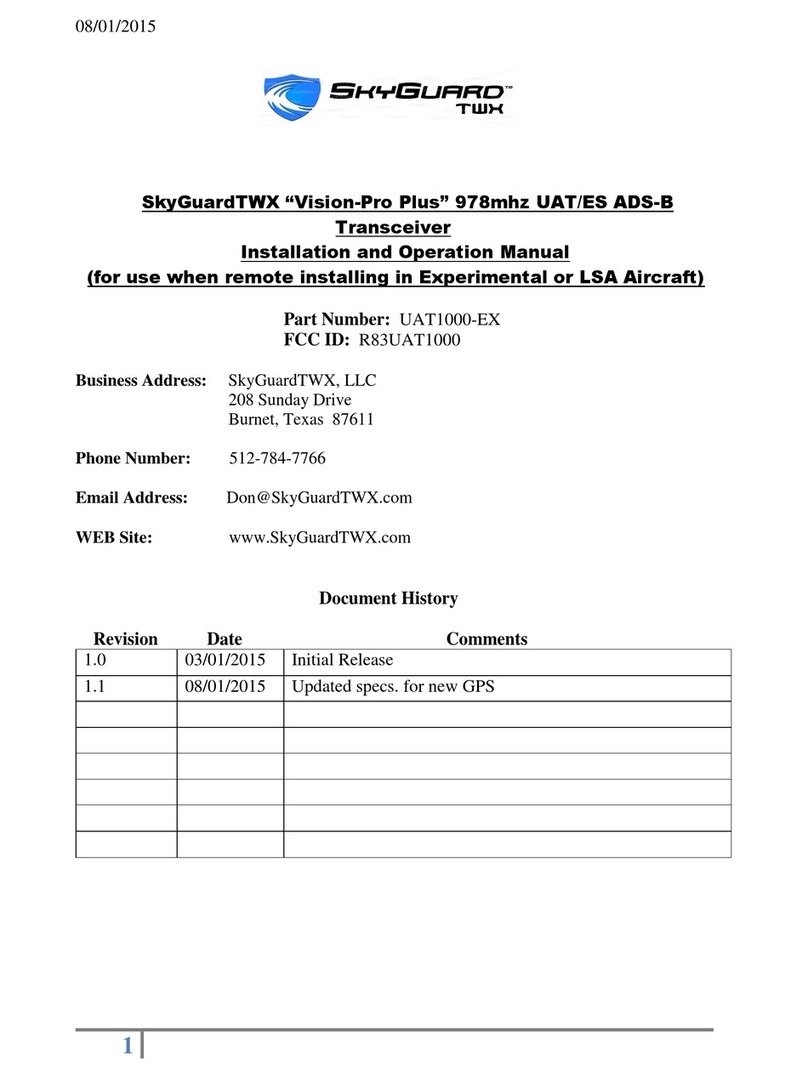
SkyGuardTWX
SkyGuardTWX Vision-Pro Plus Installation and operation manual

Kenwood
Kenwood TS-515 operating instructions
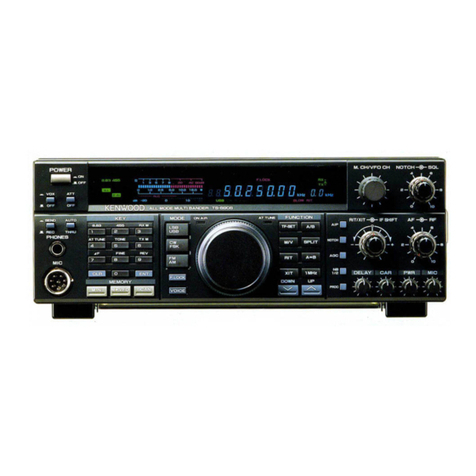
Kenwood
Kenwood TS-450S instruction manual

Elinchrom
Elinchrom EL-Skyport 19348 Instructions for use
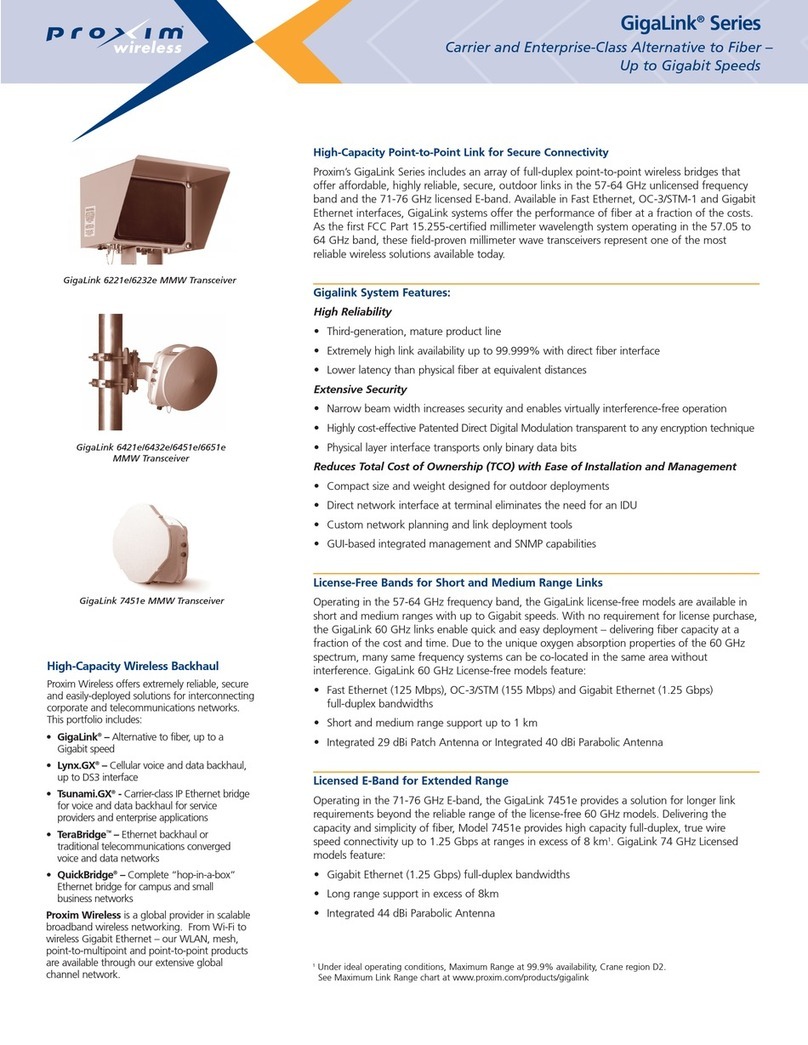
Proxim
Proxim GigaLink 6221E Specifications

Yaesu
Yaesu FTC-4610 Maintenance service manual
